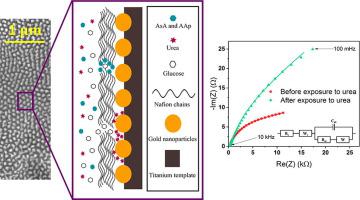Bioelectrochemistry ( IF 4.8 ) Pub Date : 2020-05-30 , DOI: 10.1016/j.bioelechem.2020.107575 Adrian Olejnik 1 , Jakub Karczewski 2 , Anna Dołęga 3 , Katarzyna Siuzdak 1 , Katarzyna Grochowska 1

|
We focus here on a novel approach to analysing the mechanisms of interference phenomena in glucose sensing, taking into account the changes within the Nafion layer deposited on the active surface. Several electrochemical techniques were used to verify the sustainability of catalytic properties of the electrode material after exposure to different compounds, i.e. ascorbic acid (AA), glycine, urea, acetylsalicylic acid (AsA), and acetaminophen (AAp). Through analysis of impedance data, we concluded that AAp and AsA were trapped permanently in the Nafion membrane, which significantly affected results repeatability. These observations were also confirmed by FT-IR investigations of the membrane after its immersion in solutions containing different interfering species. Moreover, after exposure to AsA and, unexpectedly, large concentrations of urea, the catalytic properties were completely lost, which, in consequence, make sensor reuse impossible. Such behaviour was justified by the chain reorganisation and swelling. Mechanisms involving adsorption onto the interphase and absorption in the membrane were proposed as key factors responsible for deterioration of membrane functionality and were confronted with FT-IR investigations. Following that, application of Nafion for non-invasive glucose sensor protection is unsatisfactory and cannot be considered for multiple detection procedures, especially taking into account biological fluids full of different interfering species.
中文翻译:

新型的Nafion涂层葡萄糖感测材料干扰分析方法。
考虑到沉积在活性表面上的Nafion层中的变化,我们在这里集中于一种新颖的方法来分析葡萄糖感测中干扰现象的机理。在暴露于不同的化合物(例如抗坏血酸(AA),甘氨酸,尿素,乙酰水杨酸(AsA)和对乙酰氨基酚(AAp))后,使用了几种电化学技术来验证电极材料催化性能的可持续性。通过分析阻抗数据,我们得出结论,AAp和AsA被永久困在Nafion膜中,这严重影响了结果的可重复性。这些观察结果也通过将膜浸入含有不同干扰物质的溶液中后的FT-IR研究证实。此外,在暴露于AsA和意外的高浓度尿素后,催化性能完全丧失,因此无法重复使用传感器。链重组和膨胀证明了这种行为是合理的。提出了涉及到相间吸附和在膜中吸收的机制,这是导致膜功能下降的关键因素,并且还面临着FT-IR研究的挑战。随后,Nafion在非侵入性葡萄糖传感器保护中的应用并不令人满意,并且不能考虑用于多种检测程序,特别是考虑到充满不同干扰物种的生物液体。提出了涉及相间吸附和在膜中吸收的机制,这是导致膜功能下降的关键因素,并且还面临着FT-IR研究的挑战。随后,Nafion在非侵入性葡萄糖传感器保护中的应用并不令人满意,并且不能考虑用于多种检测程序,特别是考虑到充满不同干扰物种的生物液体。提出了涉及到相间吸附和在膜中吸收的机制,这是导致膜功能下降的关键因素,并且还面临着FT-IR研究的挑战。随后,Nafion在非侵入性葡萄糖传感器保护中的应用并不令人满意,并且不能考虑用于多种检测程序,特别是考虑到充满不同干扰物种的生物液体。











































 京公网安备 11010802027423号
京公网安备 11010802027423号